Fortunately, there are many native alternatives to common invasive plants. Native plant alternatives are more sustainable, require less maintenance, and support biodiversity and wildlife.
8 Native Alternatives To Common Invasive Plants
Choosing like for like is easier than you might think when replacing exotic and invasive species. From shrubs and vines to grasses and groundcovers, there are plenty of options. Use these and other native alternatives to invasive plants you see in your garden or yard:
1. Coral Honeysuckle (Lonicera sempivirens)
Invasive honeysuckles are common and very aggressive growers. They are mostly shrubs and include Japanese, Tatarian, and Amur honeysuckles. Coral honeysuckle is a great native alternative that offers pretty, coral, trumpet-shaped flowers with a sweet smell. It’s a climbing semi-evergreen vine that blooms in spring and early summer and can be grown in zones 6 through 9.
2. Pink Muhly Grass (Muhlenbergia capillaris)
Pink muhly grass is an excellent look-alike for Chinese silver grass, an invasive that spreads aggressively. Both are showy ornamentals with striking, feathery seedheads. Pink muhly grass is hardy in zones 6 through 9 and appreciates full sun and dry, well-drained soil. It’s native to eastern and southern states.
3. American Wisteria (Wisteria frutescens)
American wisteria is a native flowering vine with grape-like clusters of purple flowers. It is native to most of the eastern U.S. and can be grown in zones 5 through 8. Use American wisteria as an alternative to invasive Chinese or Japanese wisteria, which can grow up to ten feet per year. The native species grows less quickly and provides similar flowers.
4. Wild Ginger (Asarum spp.)
Replace invasive groundcovers, like periwinkle, that can take over forest floors and smother native plants with shade-loving wild ginger. These native species grow close to the ground and have interesting foliage. Most can be grown as far north as zone 4 or 5. A cousin of the ever-present and invasive Asian wisteria, this native alternative won’t take over your yard, while still producing gorgeous, fragrant blooms.
5. Redbud (Cercis canadensis and C. occidentalis)
Eastern and western redbuds are native flowering shrubs or trees. Prune and train them to the shape of a small tree, or let them grow shrubbier and full. They make pretty alternatives to Bradford pear and princess tree, popular but invasive landscaping trees. Grow the western species in zones 6 through 9 and eastern redbud in zones 4 through 8.
6. Fothergilla (Fothergilla spp.)
Also known as witch alder, fothergilla species are native shrubs that offer four-season interest. Replace your burning bushes with a fothergilla, which has fall coloring that is just as spectacular. Fothergilla also has striking bottlebrush flowers in spring, green summer foliage, and interesting branch structures for winter interest. Grow fothergilla in sun or partial shade in zones 5 through 9.
7. Arrowwood Viburnum (Viburnum dentatum)
Use this native shrub to replace privet, a once popular hedge plant that escaped cultivation and became invasive. Native arrowwood viburnum has similar white flowers, is very hardy, and offers excellent fall color. Grow in zones 2 through 8 in moist, well-drained soil with full sun or partial shade.
8. Red Maple (Acer rubrum)
Red maple is an alternative to the ubiquitous Norway maple, which has become invasive in wooded areas, displacing many native trees. It is an excellent native shade tree with a beautiful red fall color. Grow it in zones 2 through 9.
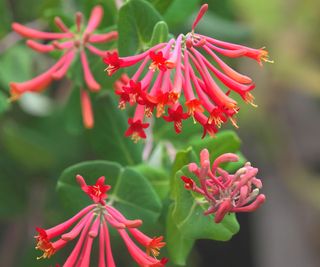
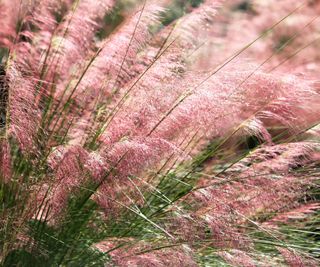
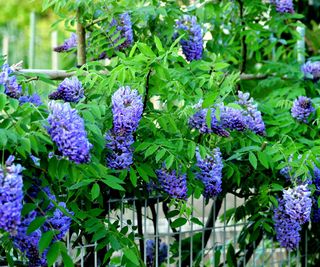
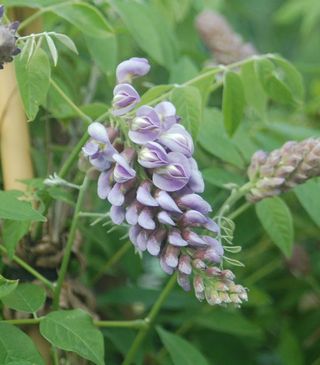
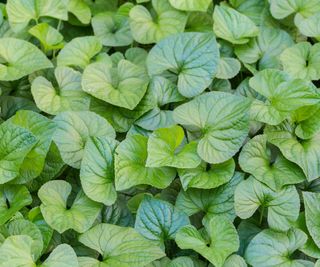

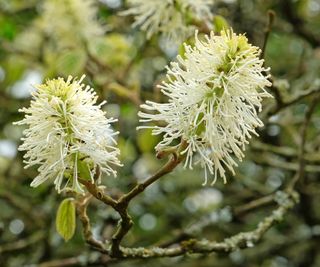
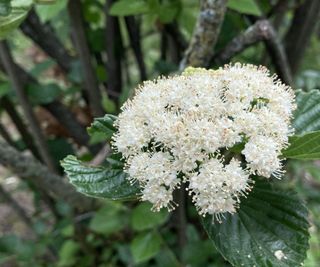
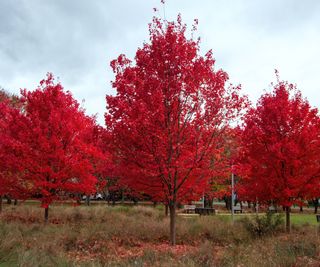
title: “Grow These 8 Gorgeous Native Alternatives To Invasive Plants” ShowToc: true date: “2024-08-27” author: “Keila Carradine”
Fortunately, there are many native alternatives to common invasive plants. Native plant alternatives are more sustainable, require less maintenance, and support biodiversity and wildlife.
8 Native Alternatives To Common Invasive Plants
Choosing like for like is easier than you might think when replacing exotic and invasive species. From shrubs and vines to grasses and groundcovers, there are plenty of options. Use these and other native alternatives to invasive plants you see in your garden or yard:
1. Coral Honeysuckle (Lonicera sempivirens)
Invasive honeysuckles are common and very aggressive growers. They are mostly shrubs and include Japanese, Tatarian, and Amur honeysuckles. Coral honeysuckle is a great native alternative that offers pretty, coral, trumpet-shaped flowers with a sweet smell. It’s a climbing semi-evergreen vine that blooms in spring and early summer and can be grown in zones 6 through 9.
2. Pink Muhly Grass (Muhlenbergia capillaris)
Pink muhly grass is an excellent look-alike for Chinese silver grass, an invasive that spreads aggressively. Both are showy ornamentals with striking, feathery seedheads. Pink muhly grass is hardy in zones 6 through 9 and appreciates full sun and dry, well-drained soil. It’s native to eastern and southern states.
3. American Wisteria (Wisteria frutescens)
American wisteria is a native flowering vine with grape-like clusters of purple flowers. It is native to most of the eastern U.S. and can be grown in zones 5 through 8. Use American wisteria as an alternative to invasive Chinese or Japanese wisteria, which can grow up to ten feet per year. The native species grows less quickly and provides similar flowers.
4. Wild Ginger (Asarum spp.)
Replace invasive groundcovers, like periwinkle, that can take over forest floors and smother native plants with shade-loving wild ginger. These native species grow close to the ground and have interesting foliage. Most can be grown as far north as zone 4 or 5. A cousin of the ever-present and invasive Asian wisteria, this native alternative won’t take over your yard, while still producing gorgeous, fragrant blooms.
5. Redbud (Cercis canadensis and C. occidentalis)
Eastern and western redbuds are native flowering shrubs or trees. Prune and train them to the shape of a small tree, or let them grow shrubbier and full. They make pretty alternatives to Bradford pear and princess tree, popular but invasive landscaping trees. Grow the western species in zones 6 through 9 and eastern redbud in zones 4 through 8.
6. Fothergilla (Fothergilla spp.)
Also known as witch alder, fothergilla species are native shrubs that offer four-season interest. Replace your burning bushes with a fothergilla, which has fall coloring that is just as spectacular. Fothergilla also has striking bottlebrush flowers in spring, green summer foliage, and interesting branch structures for winter interest. Grow fothergilla in sun or partial shade in zones 5 through 9.
7. Arrowwood Viburnum (Viburnum dentatum)
Use this native shrub to replace privet, a once popular hedge plant that escaped cultivation and became invasive. Native arrowwood viburnum has similar white flowers, is very hardy, and offers excellent fall color. Grow in zones 2 through 8 in moist, well-drained soil with full sun or partial shade.
8. Red Maple (Acer rubrum)
Red maple is an alternative to the ubiquitous Norway maple, which has become invasive in wooded areas, displacing many native trees. It is an excellent native shade tree with a beautiful red fall color. Grow it in zones 2 through 9.









title: “Grow These 8 Gorgeous Native Alternatives To Invasive Plants” ShowToc: true date: “2024-09-12” author: “Herbert Graham”
Fortunately, there are many native alternatives to common invasive plants. Native plant alternatives are more sustainable, require less maintenance, and support biodiversity and wildlife.
8 Native Alternatives To Common Invasive Plants
Choosing like for like is easier than you might think when replacing exotic and invasive species. From shrubs and vines to grasses and groundcovers, there are plenty of options. Use these and other native alternatives to invasive plants you see in your garden or yard:
1. Coral Honeysuckle (Lonicera sempivirens)
Invasive honeysuckles are common and very aggressive growers. They are mostly shrubs and include Japanese, Tatarian, and Amur honeysuckles. Coral honeysuckle is a great native alternative that offers pretty, coral, trumpet-shaped flowers with a sweet smell. It’s a climbing semi-evergreen vine that blooms in spring and early summer and can be grown in zones 6 through 9.
2. Pink Muhly Grass (Muhlenbergia capillaris)
Pink muhly grass is an excellent look-alike for Chinese silver grass, an invasive that spreads aggressively. Both are showy ornamentals with striking, feathery seedheads. Pink muhly grass is hardy in zones 6 through 9 and appreciates full sun and dry, well-drained soil. It’s native to eastern and southern states.
3. American Wisteria (Wisteria frutescens)
American wisteria is a native flowering vine with grape-like clusters of purple flowers. It is native to most of the eastern U.S. and can be grown in zones 5 through 8. Use American wisteria as an alternative to invasive Chinese or Japanese wisteria, which can grow up to ten feet per year. The native species grows less quickly and provides similar flowers.
4. Wild Ginger (Asarum spp.)
Replace invasive groundcovers, like periwinkle, that can take over forest floors and smother native plants with shade-loving wild ginger. These native species grow close to the ground and have interesting foliage. Most can be grown as far north as zone 4 or 5. A cousin of the ever-present and invasive Asian wisteria, this native alternative won’t take over your yard, while still producing gorgeous, fragrant blooms.
5. Redbud (Cercis canadensis and C. occidentalis)
Eastern and western redbuds are native flowering shrubs or trees. Prune and train them to the shape of a small tree, or let them grow shrubbier and full. They make pretty alternatives to Bradford pear and princess tree, popular but invasive landscaping trees. Grow the western species in zones 6 through 9 and eastern redbud in zones 4 through 8.
6. Fothergilla (Fothergilla spp.)
Also known as witch alder, fothergilla species are native shrubs that offer four-season interest. Replace your burning bushes with a fothergilla, which has fall coloring that is just as spectacular. Fothergilla also has striking bottlebrush flowers in spring, green summer foliage, and interesting branch structures for winter interest. Grow fothergilla in sun or partial shade in zones 5 through 9.
7. Arrowwood Viburnum (Viburnum dentatum)
Use this native shrub to replace privet, a once popular hedge plant that escaped cultivation and became invasive. Native arrowwood viburnum has similar white flowers, is very hardy, and offers excellent fall color. Grow in zones 2 through 8 in moist, well-drained soil with full sun or partial shade.
8. Red Maple (Acer rubrum)
Red maple is an alternative to the ubiquitous Norway maple, which has become invasive in wooded areas, displacing many native trees. It is an excellent native shade tree with a beautiful red fall color. Grow it in zones 2 through 9.









title: “Grow These 8 Gorgeous Native Alternatives To Invasive Plants” ShowToc: true date: “2024-09-15” author: “Michael Tucker”
Fortunately, there are many native alternatives to common invasive plants. Native plant alternatives are more sustainable, require less maintenance, and support biodiversity and wildlife.
8 Native Alternatives To Common Invasive Plants
Choosing like for like is easier than you might think when replacing exotic and invasive species. From shrubs and vines to grasses and groundcovers, there are plenty of options. Use these and other native alternatives to invasive plants you see in your garden or yard:
1. Coral Honeysuckle (Lonicera sempivirens)
Invasive honeysuckles are common and very aggressive growers. They are mostly shrubs and include Japanese, Tatarian, and Amur honeysuckles. Coral honeysuckle is a great native alternative that offers pretty, coral, trumpet-shaped flowers with a sweet smell. It’s a climbing semi-evergreen vine that blooms in spring and early summer and can be grown in zones 6 through 9.
2. Pink Muhly Grass (Muhlenbergia capillaris)
Pink muhly grass is an excellent look-alike for Chinese silver grass, an invasive that spreads aggressively. Both are showy ornamentals with striking, feathery seedheads. Pink muhly grass is hardy in zones 6 through 9 and appreciates full sun and dry, well-drained soil. It’s native to eastern and southern states.
3. American Wisteria (Wisteria frutescens)
American wisteria is a native flowering vine with grape-like clusters of purple flowers. It is native to most of the eastern U.S. and can be grown in zones 5 through 8. Use American wisteria as an alternative to invasive Chinese or Japanese wisteria, which can grow up to ten feet per year. The native species grows less quickly and provides similar flowers.
4. Wild Ginger (Asarum spp.)
Replace invasive groundcovers, like periwinkle, that can take over forest floors and smother native plants with shade-loving wild ginger. These native species grow close to the ground and have interesting foliage. Most can be grown as far north as zone 4 or 5. A cousin of the ever-present and invasive Asian wisteria, this native alternative won’t take over your yard, while still producing gorgeous, fragrant blooms.
5. Redbud (Cercis canadensis and C. occidentalis)
Eastern and western redbuds are native flowering shrubs or trees. Prune and train them to the shape of a small tree, or let them grow shrubbier and full. They make pretty alternatives to Bradford pear and princess tree, popular but invasive landscaping trees. Grow the western species in zones 6 through 9 and eastern redbud in zones 4 through 8.
6. Fothergilla (Fothergilla spp.)
Also known as witch alder, fothergilla species are native shrubs that offer four-season interest. Replace your burning bushes with a fothergilla, which has fall coloring that is just as spectacular. Fothergilla also has striking bottlebrush flowers in spring, green summer foliage, and interesting branch structures for winter interest. Grow fothergilla in sun or partial shade in zones 5 through 9.
7. Arrowwood Viburnum (Viburnum dentatum)
Use this native shrub to replace privet, a once popular hedge plant that escaped cultivation and became invasive. Native arrowwood viburnum has similar white flowers, is very hardy, and offers excellent fall color. Grow in zones 2 through 8 in moist, well-drained soil with full sun or partial shade.
8. Red Maple (Acer rubrum)
Red maple is an alternative to the ubiquitous Norway maple, which has become invasive in wooded areas, displacing many native trees. It is an excellent native shade tree with a beautiful red fall color. Grow it in zones 2 through 9.









title: “Grow These 8 Gorgeous Native Alternatives To Invasive Plants” ShowToc: true date: “2024-09-27” author: “Robert Crays”
Fortunately, there are many native alternatives to common invasive plants. Native plant alternatives are more sustainable, require less maintenance, and support biodiversity and wildlife.
8 Native Alternatives To Common Invasive Plants
Choosing like for like is easier than you might think when replacing exotic and invasive species. From shrubs and vines to grasses and groundcovers, there are plenty of options. Use these and other native alternatives to invasive plants you see in your garden or yard:
1. Coral Honeysuckle (Lonicera sempivirens)
Invasive honeysuckles are common and very aggressive growers. They are mostly shrubs and include Japanese, Tatarian, and Amur honeysuckles. Coral honeysuckle is a great native alternative that offers pretty, coral, trumpet-shaped flowers with a sweet smell. It’s a climbing semi-evergreen vine that blooms in spring and early summer and can be grown in zones 6 through 9.
2. Pink Muhly Grass (Muhlenbergia capillaris)
Pink muhly grass is an excellent look-alike for Chinese silver grass, an invasive that spreads aggressively. Both are showy ornamentals with striking, feathery seedheads. Pink muhly grass is hardy in zones 6 through 9 and appreciates full sun and dry, well-drained soil. It’s native to eastern and southern states.
3. American Wisteria (Wisteria frutescens)
American wisteria is a native flowering vine with grape-like clusters of purple flowers. It is native to most of the eastern U.S. and can be grown in zones 5 through 8. Use American wisteria as an alternative to invasive Chinese or Japanese wisteria, which can grow up to ten feet per year. The native species grows less quickly and provides similar flowers.
4. Wild Ginger (Asarum spp.)
Replace invasive groundcovers, like periwinkle, that can take over forest floors and smother native plants with shade-loving wild ginger. These native species grow close to the ground and have interesting foliage. Most can be grown as far north as zone 4 or 5. A cousin of the ever-present and invasive Asian wisteria, this native alternative won’t take over your yard, while still producing gorgeous, fragrant blooms.
5. Redbud (Cercis canadensis and C. occidentalis)
Eastern and western redbuds are native flowering shrubs or trees. Prune and train them to the shape of a small tree, or let them grow shrubbier and full. They make pretty alternatives to Bradford pear and princess tree, popular but invasive landscaping trees. Grow the western species in zones 6 through 9 and eastern redbud in zones 4 through 8.
6. Fothergilla (Fothergilla spp.)
Also known as witch alder, fothergilla species are native shrubs that offer four-season interest. Replace your burning bushes with a fothergilla, which has fall coloring that is just as spectacular. Fothergilla also has striking bottlebrush flowers in spring, green summer foliage, and interesting branch structures for winter interest. Grow fothergilla in sun or partial shade in zones 5 through 9.
7. Arrowwood Viburnum (Viburnum dentatum)
Use this native shrub to replace privet, a once popular hedge plant that escaped cultivation and became invasive. Native arrowwood viburnum has similar white flowers, is very hardy, and offers excellent fall color. Grow in zones 2 through 8 in moist, well-drained soil with full sun or partial shade.
8. Red Maple (Acer rubrum)
Red maple is an alternative to the ubiquitous Norway maple, which has become invasive in wooded areas, displacing many native trees. It is an excellent native shade tree with a beautiful red fall color. Grow it in zones 2 through 9.









title: “Grow These 8 Gorgeous Native Alternatives To Invasive Plants” ShowToc: true date: “2024-10-08” author: “Dorothy Bland”
Fortunately, there are many native alternatives to common invasive plants. Native plant alternatives are more sustainable, require less maintenance, and support biodiversity and wildlife.
8 Native Alternatives To Common Invasive Plants
Choosing like for like is easier than you might think when replacing exotic and invasive species. From shrubs and vines to grasses and groundcovers, there are plenty of options. Use these and other native alternatives to invasive plants you see in your garden or yard:
1. Coral Honeysuckle (Lonicera sempivirens)
Invasive honeysuckles are common and very aggressive growers. They are mostly shrubs and include Japanese, Tatarian, and Amur honeysuckles. Coral honeysuckle is a great native alternative that offers pretty, coral, trumpet-shaped flowers with a sweet smell. It’s a climbing semi-evergreen vine that blooms in spring and early summer and can be grown in zones 6 through 9.
2. Pink Muhly Grass (Muhlenbergia capillaris)
Pink muhly grass is an excellent look-alike for Chinese silver grass, an invasive that spreads aggressively. Both are showy ornamentals with striking, feathery seedheads. Pink muhly grass is hardy in zones 6 through 9 and appreciates full sun and dry, well-drained soil. It’s native to eastern and southern states.
3. American Wisteria (Wisteria frutescens)
American wisteria is a native flowering vine with grape-like clusters of purple flowers. It is native to most of the eastern U.S. and can be grown in zones 5 through 8. Use American wisteria as an alternative to invasive Chinese or Japanese wisteria, which can grow up to ten feet per year. The native species grows less quickly and provides similar flowers.
4. Wild Ginger (Asarum spp.)
Replace invasive groundcovers, like periwinkle, that can take over forest floors and smother native plants with shade-loving wild ginger. These native species grow close to the ground and have interesting foliage. Most can be grown as far north as zone 4 or 5. A cousin of the ever-present and invasive Asian wisteria, this native alternative won’t take over your yard, while still producing gorgeous, fragrant blooms.
5. Redbud (Cercis canadensis and C. occidentalis)
Eastern and western redbuds are native flowering shrubs or trees. Prune and train them to the shape of a small tree, or let them grow shrubbier and full. They make pretty alternatives to Bradford pear and princess tree, popular but invasive landscaping trees. Grow the western species in zones 6 through 9 and eastern redbud in zones 4 through 8.
6. Fothergilla (Fothergilla spp.)
Also known as witch alder, fothergilla species are native shrubs that offer four-season interest. Replace your burning bushes with a fothergilla, which has fall coloring that is just as spectacular. Fothergilla also has striking bottlebrush flowers in spring, green summer foliage, and interesting branch structures for winter interest. Grow fothergilla in sun or partial shade in zones 5 through 9.
7. Arrowwood Viburnum (Viburnum dentatum)
Use this native shrub to replace privet, a once popular hedge plant that escaped cultivation and became invasive. Native arrowwood viburnum has similar white flowers, is very hardy, and offers excellent fall color. Grow in zones 2 through 8 in moist, well-drained soil with full sun or partial shade.
8. Red Maple (Acer rubrum)
Red maple is an alternative to the ubiquitous Norway maple, which has become invasive in wooded areas, displacing many native trees. It is an excellent native shade tree with a beautiful red fall color. Grow it in zones 2 through 9.









title: “Grow These 8 Gorgeous Native Alternatives To Invasive Plants” ShowToc: true date: “2024-08-31” author: “Nelson Alexander”
Fortunately, there are many native alternatives to common invasive plants. Native plant alternatives are more sustainable, require less maintenance, and support biodiversity and wildlife.
8 Native Alternatives To Common Invasive Plants
Choosing like for like is easier than you might think when replacing exotic and invasive species. From shrubs and vines to grasses and groundcovers, there are plenty of options. Use these and other native alternatives to invasive plants you see in your garden or yard:
1. Coral Honeysuckle (Lonicera sempivirens)
Invasive honeysuckles are common and very aggressive growers. They are mostly shrubs and include Japanese, Tatarian, and Amur honeysuckles. Coral honeysuckle is a great native alternative that offers pretty, coral, trumpet-shaped flowers with a sweet smell. It’s a climbing semi-evergreen vine that blooms in spring and early summer and can be grown in zones 6 through 9.
2. Pink Muhly Grass (Muhlenbergia capillaris)
Pink muhly grass is an excellent look-alike for Chinese silver grass, an invasive that spreads aggressively. Both are showy ornamentals with striking, feathery seedheads. Pink muhly grass is hardy in zones 6 through 9 and appreciates full sun and dry, well-drained soil. It’s native to eastern and southern states.
3. American Wisteria (Wisteria frutescens)
American wisteria is a native flowering vine with grape-like clusters of purple flowers. It is native to most of the eastern U.S. and can be grown in zones 5 through 8. Use American wisteria as an alternative to invasive Chinese or Japanese wisteria, which can grow up to ten feet per year. The native species grows less quickly and provides similar flowers.
4. Wild Ginger (Asarum spp.)
Replace invasive groundcovers, like periwinkle, that can take over forest floors and smother native plants with shade-loving wild ginger. These native species grow close to the ground and have interesting foliage. Most can be grown as far north as zone 4 or 5. A cousin of the ever-present and invasive Asian wisteria, this native alternative won’t take over your yard, while still producing gorgeous, fragrant blooms.
5. Redbud (Cercis canadensis and C. occidentalis)
Eastern and western redbuds are native flowering shrubs or trees. Prune and train them to the shape of a small tree, or let them grow shrubbier and full. They make pretty alternatives to Bradford pear and princess tree, popular but invasive landscaping trees. Grow the western species in zones 6 through 9 and eastern redbud in zones 4 through 8.
6. Fothergilla (Fothergilla spp.)
Also known as witch alder, fothergilla species are native shrubs that offer four-season interest. Replace your burning bushes with a fothergilla, which has fall coloring that is just as spectacular. Fothergilla also has striking bottlebrush flowers in spring, green summer foliage, and interesting branch structures for winter interest. Grow fothergilla in sun or partial shade in zones 5 through 9.
7. Arrowwood Viburnum (Viburnum dentatum)
Use this native shrub to replace privet, a once popular hedge plant that escaped cultivation and became invasive. Native arrowwood viburnum has similar white flowers, is very hardy, and offers excellent fall color. Grow in zones 2 through 8 in moist, well-drained soil with full sun or partial shade.
8. Red Maple (Acer rubrum)
Red maple is an alternative to the ubiquitous Norway maple, which has become invasive in wooded areas, displacing many native trees. It is an excellent native shade tree with a beautiful red fall color. Grow it in zones 2 through 9.









title: “Grow These 8 Gorgeous Native Alternatives To Invasive Plants” ShowToc: true date: “2024-10-16” author: “Mary Carpenter”
Fortunately, there are many native alternatives to common invasive plants. Native plant alternatives are more sustainable, require less maintenance, and support biodiversity and wildlife.
8 Native Alternatives To Common Invasive Plants
Choosing like for like is easier than you might think when replacing exotic and invasive species. From shrubs and vines to grasses and groundcovers, there are plenty of options. Use these and other native alternatives to invasive plants you see in your garden or yard:
1. Coral Honeysuckle (Lonicera sempivirens)
Invasive honeysuckles are common and very aggressive growers. They are mostly shrubs and include Japanese, Tatarian, and Amur honeysuckles. Coral honeysuckle is a great native alternative that offers pretty, coral, trumpet-shaped flowers with a sweet smell. It’s a climbing semi-evergreen vine that blooms in spring and early summer and can be grown in zones 6 through 9.
2. Pink Muhly Grass (Muhlenbergia capillaris)
Pink muhly grass is an excellent look-alike for Chinese silver grass, an invasive that spreads aggressively. Both are showy ornamentals with striking, feathery seedheads. Pink muhly grass is hardy in zones 6 through 9 and appreciates full sun and dry, well-drained soil. It’s native to eastern and southern states.
3. American Wisteria (Wisteria frutescens)
American wisteria is a native flowering vine with grape-like clusters of purple flowers. It is native to most of the eastern U.S. and can be grown in zones 5 through 8. Use American wisteria as an alternative to invasive Chinese or Japanese wisteria, which can grow up to ten feet per year. The native species grows less quickly and provides similar flowers.
4. Wild Ginger (Asarum spp.)
Replace invasive groundcovers, like periwinkle, that can take over forest floors and smother native plants with shade-loving wild ginger. These native species grow close to the ground and have interesting foliage. Most can be grown as far north as zone 4 or 5. A cousin of the ever-present and invasive Asian wisteria, this native alternative won’t take over your yard, while still producing gorgeous, fragrant blooms.
5. Redbud (Cercis canadensis and C. occidentalis)
Eastern and western redbuds are native flowering shrubs or trees. Prune and train them to the shape of a small tree, or let them grow shrubbier and full. They make pretty alternatives to Bradford pear and princess tree, popular but invasive landscaping trees. Grow the western species in zones 6 through 9 and eastern redbud in zones 4 through 8.
6. Fothergilla (Fothergilla spp.)
Also known as witch alder, fothergilla species are native shrubs that offer four-season interest. Replace your burning bushes with a fothergilla, which has fall coloring that is just as spectacular. Fothergilla also has striking bottlebrush flowers in spring, green summer foliage, and interesting branch structures for winter interest. Grow fothergilla in sun or partial shade in zones 5 through 9.
7. Arrowwood Viburnum (Viburnum dentatum)
Use this native shrub to replace privet, a once popular hedge plant that escaped cultivation and became invasive. Native arrowwood viburnum has similar white flowers, is very hardy, and offers excellent fall color. Grow in zones 2 through 8 in moist, well-drained soil with full sun or partial shade.
8. Red Maple (Acer rubrum)
Red maple is an alternative to the ubiquitous Norway maple, which has become invasive in wooded areas, displacing many native trees. It is an excellent native shade tree with a beautiful red fall color. Grow it in zones 2 through 9.









title: “Grow These 8 Gorgeous Native Alternatives To Invasive Plants” ShowToc: true date: “2024-10-05” author: “Michele Kiernan”
Fortunately, there are many native alternatives to common invasive plants. Native plant alternatives are more sustainable, require less maintenance, and support biodiversity and wildlife.
8 Native Alternatives To Common Invasive Plants
Choosing like for like is easier than you might think when replacing exotic and invasive species. From shrubs and vines to grasses and groundcovers, there are plenty of options. Use these and other native alternatives to invasive plants you see in your garden or yard:
1. Coral Honeysuckle (Lonicera sempivirens)
Invasive honeysuckles are common and very aggressive growers. They are mostly shrubs and include Japanese, Tatarian, and Amur honeysuckles. Coral honeysuckle is a great native alternative that offers pretty, coral, trumpet-shaped flowers with a sweet smell. It’s a climbing semi-evergreen vine that blooms in spring and early summer and can be grown in zones 6 through 9.
2. Pink Muhly Grass (Muhlenbergia capillaris)
Pink muhly grass is an excellent look-alike for Chinese silver grass, an invasive that spreads aggressively. Both are showy ornamentals with striking, feathery seedheads. Pink muhly grass is hardy in zones 6 through 9 and appreciates full sun and dry, well-drained soil. It’s native to eastern and southern states.
3. American Wisteria (Wisteria frutescens)
American wisteria is a native flowering vine with grape-like clusters of purple flowers. It is native to most of the eastern U.S. and can be grown in zones 5 through 8. Use American wisteria as an alternative to invasive Chinese or Japanese wisteria, which can grow up to ten feet per year. The native species grows less quickly and provides similar flowers.
4. Wild Ginger (Asarum spp.)
Replace invasive groundcovers, like periwinkle, that can take over forest floors and smother native plants with shade-loving wild ginger. These native species grow close to the ground and have interesting foliage. Most can be grown as far north as zone 4 or 5. A cousin of the ever-present and invasive Asian wisteria, this native alternative won’t take over your yard, while still producing gorgeous, fragrant blooms.
5. Redbud (Cercis canadensis and C. occidentalis)
Eastern and western redbuds are native flowering shrubs or trees. Prune and train them to the shape of a small tree, or let them grow shrubbier and full. They make pretty alternatives to Bradford pear and princess tree, popular but invasive landscaping trees. Grow the western species in zones 6 through 9 and eastern redbud in zones 4 through 8.
6. Fothergilla (Fothergilla spp.)
Also known as witch alder, fothergilla species are native shrubs that offer four-season interest. Replace your burning bushes with a fothergilla, which has fall coloring that is just as spectacular. Fothergilla also has striking bottlebrush flowers in spring, green summer foliage, and interesting branch structures for winter interest. Grow fothergilla in sun or partial shade in zones 5 through 9.
7. Arrowwood Viburnum (Viburnum dentatum)
Use this native shrub to replace privet, a once popular hedge plant that escaped cultivation and became invasive. Native arrowwood viburnum has similar white flowers, is very hardy, and offers excellent fall color. Grow in zones 2 through 8 in moist, well-drained soil with full sun or partial shade.
8. Red Maple (Acer rubrum)
Red maple is an alternative to the ubiquitous Norway maple, which has become invasive in wooded areas, displacing many native trees. It is an excellent native shade tree with a beautiful red fall color. Grow it in zones 2 through 9.









title: “Grow These 8 Gorgeous Native Alternatives To Invasive Plants” ShowToc: true date: “2024-09-29” author: “William Pierce”
Fortunately, there are many native alternatives to common invasive plants. Native plant alternatives are more sustainable, require less maintenance, and support biodiversity and wildlife.
8 Native Alternatives To Common Invasive Plants
Choosing like for like is easier than you might think when replacing exotic and invasive species. From shrubs and vines to grasses and groundcovers, there are plenty of options. Use these and other native alternatives to invasive plants you see in your garden or yard:
1. Coral Honeysuckle (Lonicera sempivirens)
Invasive honeysuckles are common and very aggressive growers. They are mostly shrubs and include Japanese, Tatarian, and Amur honeysuckles. Coral honeysuckle is a great native alternative that offers pretty, coral, trumpet-shaped flowers with a sweet smell. It’s a climbing semi-evergreen vine that blooms in spring and early summer and can be grown in zones 6 through 9.
2. Pink Muhly Grass (Muhlenbergia capillaris)
Pink muhly grass is an excellent look-alike for Chinese silver grass, an invasive that spreads aggressively. Both are showy ornamentals with striking, feathery seedheads. Pink muhly grass is hardy in zones 6 through 9 and appreciates full sun and dry, well-drained soil. It’s native to eastern and southern states.
3. American Wisteria (Wisteria frutescens)
American wisteria is a native flowering vine with grape-like clusters of purple flowers. It is native to most of the eastern U.S. and can be grown in zones 5 through 8. Use American wisteria as an alternative to invasive Chinese or Japanese wisteria, which can grow up to ten feet per year. The native species grows less quickly and provides similar flowers.
4. Wild Ginger (Asarum spp.)
Replace invasive groundcovers, like periwinkle, that can take over forest floors and smother native plants with shade-loving wild ginger. These native species grow close to the ground and have interesting foliage. Most can be grown as far north as zone 4 or 5. A cousin of the ever-present and invasive Asian wisteria, this native alternative won’t take over your yard, while still producing gorgeous, fragrant blooms.
5. Redbud (Cercis canadensis and C. occidentalis)
Eastern and western redbuds are native flowering shrubs or trees. Prune and train them to the shape of a small tree, or let them grow shrubbier and full. They make pretty alternatives to Bradford pear and princess tree, popular but invasive landscaping trees. Grow the western species in zones 6 through 9 and eastern redbud in zones 4 through 8.
6. Fothergilla (Fothergilla spp.)
Also known as witch alder, fothergilla species are native shrubs that offer four-season interest. Replace your burning bushes with a fothergilla, which has fall coloring that is just as spectacular. Fothergilla also has striking bottlebrush flowers in spring, green summer foliage, and interesting branch structures for winter interest. Grow fothergilla in sun or partial shade in zones 5 through 9.
7. Arrowwood Viburnum (Viburnum dentatum)
Use this native shrub to replace privet, a once popular hedge plant that escaped cultivation and became invasive. Native arrowwood viburnum has similar white flowers, is very hardy, and offers excellent fall color. Grow in zones 2 through 8 in moist, well-drained soil with full sun or partial shade.
8. Red Maple (Acer rubrum)
Red maple is an alternative to the ubiquitous Norway maple, which has become invasive in wooded areas, displacing many native trees. It is an excellent native shade tree with a beautiful red fall color. Grow it in zones 2 through 9.








